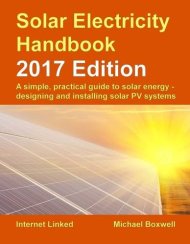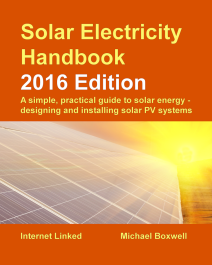Living off-grid is an aspiration for many people. You may want to ‘grow your own’ electricity and not be reliant on electricity companies. You may live in the middle of nowhere and be unable to get an outside electricity supply. Whatever your motive, there are many attractions for using solar power to create complete self-sufficiency.
Do not confuse living off-grid with a grid-tie installation and achieving a balance where energy exported to the grid minus energy imported from the grid equals a zero overall import of electricity. A genuinely off-grid system means you use the electricity you generate every time you switch on a light bulb or turn on the TV. If you do not have enough electricity, nothing happens.
Before you start, be under no illusions. This is going to be an expensive project and for most people it will involve making some significant compromises on power usage in order to make living off-grid a reality.
In this book, I have been using the example of a holiday home. The difference between a holiday home and a main home is significant. If you are planning to live off-grid all the time, you may not be so willing to give up some of the creature comforts that this entails. Compromises that you may be prepared to accept for a few days or weeks may not be so desirable for a home you are living in for fifty-two weeks a year.
Remember that a solar electric system is a long-term investment, but will require long-term compromises as well. You will not have limitless electricity available when you have a solar electric system, and this can mean limiting your choices later on. If you have children at home, consider their needs as well. They will increase as they become teenagers and they may not be so happy about making the same compromises that you are.
You need to be able to provide enough power to live through the winter as well as the summer. You will probably use more electricity during the winter than the summer: more lighting and more time spent inside the house mean higher power requirements.
Most off-grid installations involve a variety of power sources, such as a solar electric system, a wind turbine and possibly a hydro-generation system if you have a fast-flowing stream with a steep enough drop. Of these technologies, only hydro on a suitable stream has the ability to generate electricity 24 hours a day, seven days a week.
In addition to using solar, wind and hydro for electrical generation, a solar water system will help heat up water and a ground source heat pump may be used to help heat the home.
When installing these systems in a home, it is important to have a failover system in place. A failover is simply a power backup so that if the power generation is insufficient to cope with your needs, a backup system cuts in.
Diesel generators are often used for this purpose. Some of the more expensive solar controllers have the facility to work with a diesel generator, automatically starting up the generator in order to charge up your batteries if the battery bank runs too low on power. Advanced solar controllers with this facility can link this in with a timer to make sure the generator does not start running at night when the noise may be inappropriate.
A solar electric system in conjunction with grid electricity
Traditionally, it has rarely made economic sense to install a solar electric system for this purpose. This has changed over the past three years, with the availability of financial assistance in many parts of the world.
If you are considering installing a system purely on environmental grounds, make sure that what you are installing actually does make a difference to the environment. If you are planning to sell back electricity to the utility grids during the day, then unless peak demand for electricity in your area coincides with the times your solar system is generating electricity, you are actually unlikely to be making any real difference whatsoever.
A solar energy system in the southern states of America can make a difference to the environment, as peak demand for electricity tends to be when the sun is shining and everyone is running air conditioning units. A grid-tie solar energy system in the United Kingdom is unlikely to make a real difference to the environment unless you are using the electricity yourself or you live in an industrial area where there is high demand for electricity during the day.
If you are in the United Kingdom or Canada and are installing a solar energy system for the primary motive of reducing your carbon impact, a grid fallback system is the most environmentally friendly solution. In this scenario, you do not export energy back to the grid, but store it and use it yourself. When the batteries have run down, your power supply switches back to the grid. There is more information on this configuration later in this chapter.
There may be other factors that make solar energy useful. For example, ensuring an electrical supply in an area with frequent power cuts, using the solar system in conjunction with an electric car, or for environmental reasons where the environmental benefits of the system have been properly assessed.
One of the benefits of building a system to work in conjunction with a conventional power supply is that you can take it step by step, implementing a smaller system and growing it as and when finances allow.
As outlined in chapter three, there are three ways to build a solar electric system in conjunction with the grid: a grid-tie system, a grid interactive system and grid fallback.
You can choose to link your solar array into the grid as a grid-tied system if you wish, so that you supply electricity to the grid when your solar array is generating the majority of its electricity and you use the grid as your battery. It is worth noting that if there is a power cut in your area, your solar electric system will be switched off as a safety precaution, which means you will not be able to use the power from your solar electric system to run your home, should there be a power cut.
Alternatively, you can design a stand-alone solar electric system to run some of your circuits in your house, either at grid-level AC voltage or on a DC low-voltage system. Lighting is a popular circuit to choose, as it is a relatively low demand circuit to start with.
Grid Fallback and Grid Failover systems
As a third alternative, you can wire your solar electric system to run some or all of the circuits in your house, but use an AC relay to switch between your solar electric system when power is available, and electricity from the grid when your battery levels drop too low. In other words, you are using the grid as a power backup, should your solar electric system not provide enough power. This setup is known as a grid fallback system.
Grid fallback and grid failover are both often overlooked as a configuration for solar power. Both these systems provide AC power to a building alongside the normal electricity supply and provide the benefit of continued power availability in the case of a power cut.
For smaller systems, a solar electric emergency power system can be cost-competitive with installing an emergency power generator and uninterruptable power supplies. A solar electric emergency power system also has the benefit of providing power all of the time, thereby reducing ongoing electricity bills as well as providing power backup.
The difference between a grid fallback system and a grid failover system is in the configuration of the system. A grid fallback system provides solar power for as much of the time as possible, only switching back to the grid when the batteries are flat. A grid failover system cuts in when there is a power cut.
Most backup power systems provide limited power to help tide premises over a short-term power cut of 24 hours or less. Typically, a backup power system would provide lighting, enough electricity to run a heating system and enough electricity for a few essential devices.
As with all other solar projects, you must start with a project scope. An example scope for a backup power project in a small business could be to provide electricity for lighting and for four PCs and to run the gas central heating for a maximum of one day in the event of a power failure.
If your premises have a number of appliances that have a high-energy use, such as open fridges and freezer units, for example, it is probably not cost-effective to use solar power for a backup power source.
Installing any backup power system will require a certain amount of rewiring. Typically, you will install a secondary distribution panel (also known as a consumer unit) containing the essential circuits, and connect this after your main distribution panel. You then install an AC relay or an Automatic Transfer Switch between your main distribution panel and the secondary distribution panel, allowing you to switch between your main power source and your backup source:
In this above diagram, a second consumer box has been wired into the electrical system, with power feeds from both the main consumer box and an inverter connected to a solar system.
Switching between the two power feeds is an automatic transfer box. If you are configuring this system to be a grid fallback system, this transfer box is configured to take power from the solar system when it is available, but then switches back to grid-sourced electricity if the batteries on the solar system have run down.
This provides a backup for critical power when the normal electricity supply is not available, but also uses the power from the solar system to run your devices when this is available.
If you are configuring this system to be a grid failover system, the transfer box is configured to take power from the normal electricity supply when it is available, but then switches to power from the solar system if it is not.
One issue with this system is that when the transfer box switches between one power source and the other, there may be a very short loss of power of around 1/20 of a second. This will cause lights to flicker momentarily, and in some cases may reset electronic equipment such as computers, TVs and DVD players.
Many modern transfer boxes transfer power so quickly that this is not a problem. However, if you do experience this problem it can be resolved by installing a small uninterruptable power supply (UPS) on any equipment affected in this way.
You can buy fully built-up automatic transfer boxes, or you can build your own relatively easily and cheaply using a high-voltage AC Double-Pole/ Double-Throw (DPDT) Power Relay, wired so that when the inverter is providing power, the relay takes power from the solar system, and when the inverter switches off, the relay switches the power supply back to the normal electricity supply.







 ‘
‘